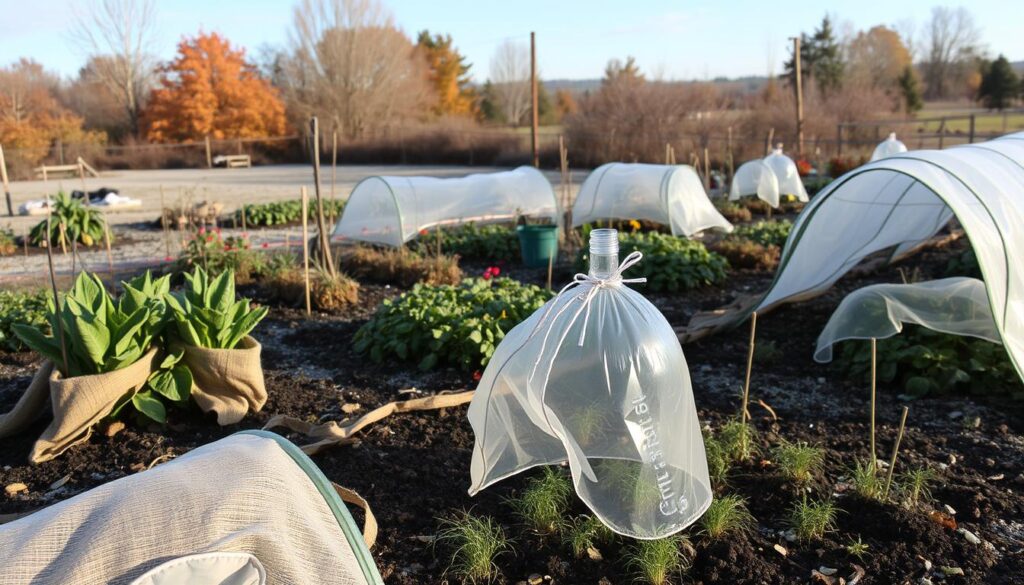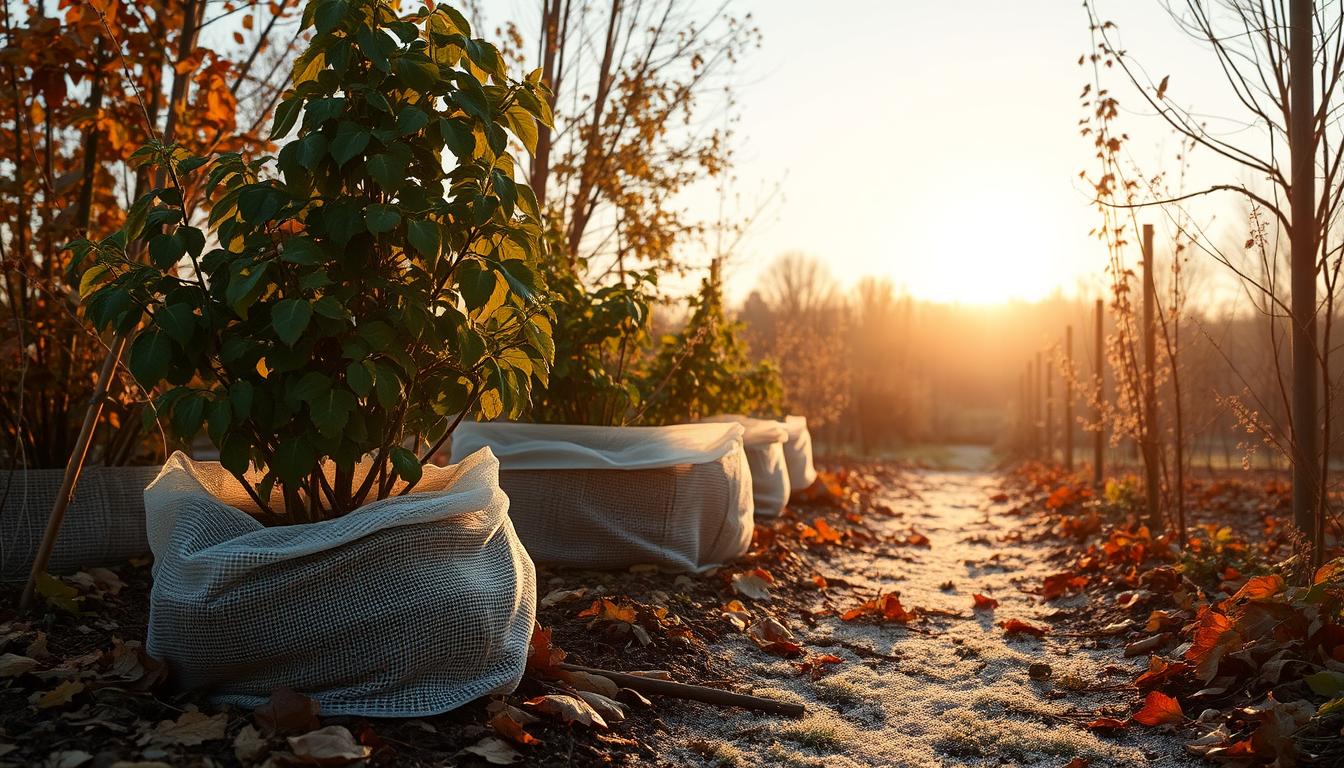A landscape glistening under the light dusting of frost can seem like a fairytale image. But for gardeners, it can mean trouble. Early frosts can damage or kill plants, cutting the growing season short.
However, with the right preparation and techniques, you can shield your garden from the chilliest of nights. By understanding frost, recognizing its impact on plants, and using effective protection methods, you can extend the growing season. This way, you can protect your hard work.
Key Takeaways
- Early frosts can pose a significant threat to your garden’s plants and cut the growing season short.
- Understanding the different types of frost and their impact on plants is crucial for effective protection.
- Implementing various frost protection techniques, such as insulation and cold-weather gardening tips, can help extend the growing season.
- Preparing your garden for early frosts requires a proactive approach to safeguard your hard work.
- By taking the necessary steps, you can protect your garden and enjoy a longer, more bountiful growing season.
Understanding Frost and Its Impact on Plants
Frost is a natural event that can greatly affect your garden. It appears as a white or gray layer on surfaces during clear, damp nights when temperatures fall below 32°F. This leads to ice crystals forming, which can harm the water inside plant cells.
What is Frost?
Frost occurs when water vapor in the air freezes on surfaces as temperatures drop below freezing. This happens on clear, calm nights when the air gets cold enough for water vapor to condense and freeze. It creates those beautiful, sparkling ice crystals.
Types of Frost
There are various types of frost, each affecting plants differently:
- Light Frost: This type occurs when temperatures are between 28°F and 32°F for a few hours. Some plants can survive it.
- Hard or Killing Frost: If temperatures fall below 25°F for over 4 hours, it can severely damage or even kill most plants.
Knowing about the different frosts and their effects on plants is key to protecting your garden from early frosts.
| Frost Type | Temperature Range | Impact on Plants |
|---|---|---|
| Light Frost | 28°F to 32°F | Some established plants can tolerate this |
| Hard or Killing Frost | Below 25°F for at least 4 hours | Can be devastating, causing significant damage or killing most plants |
“Understanding the different types of frost and their effects on plants is crucial for protecting your garden.”
How to Protect Your Garden from Early Frosts
As the colder months come, it’s key to protect your garden from early frosts. Luckily, there are many ways to keep your plants safe and ensure a good harvest.
Covering Plants with Fabric
One simple and cheap way to protect your plants is by using fabrics like row covers or plant blankets. These materials trap heat, keeping frost away from your plants.
Building Hoop Houses and Cold Frames
For better protection, think about making hoop houses or cold frames. These structures act like mini greenhouses. They let your plants grow longer and keep them safe from frost.
Mulching the Soil
Putting a thick layer of organic mulch, like straw, leaves, or wood chips, around your plants helps too. It insulates the soil and keeps it from freezing. This keeps the plant roots at a stable temperature.
Watering Plants Thoroughly
Watering your plants during the day can also help them handle the cold at night. The soil’s moisture helps keep heat in, acting as a natural insulator for the roots.
Bringing Container Plants Indoors
For potted plants, the best move is to bring them inside or group them in a safe spot. This keeps them away from the cold and ensures they stay warm and safe.
Using these strategies, you can protect your garden and keep the growing season longer. This way, you can enjoy a full harvest even when there are early frosts.

| Frost Protection Technique | Description | Benefits |
|---|---|---|
| Plant Covers | Covering plants with fabrics, row covers, or plant blankets | Traps heat, prevents frost damage |
| Hoop Houses and Cold Frames | Constructing simple structures to create a miniature greenhouse environment | Extends growing season, protects plants from frost |
| Mulching | Applying a thick layer of organic material around plant roots | Insulates soil, prevents freezing |
| Watering | Thoroughly watering plants during the day | Helps soil absorb and retain heat, acts as a natural insulator |
| Bringing Plants Indoors | Moving potted plants into a sheltered indoor space | Protects plants from harsh outdoor conditions |
Conclusion
Early frosts can be tough for gardeners, but you can beat them with the right steps. By learning how frost affects plants, you can protect your garden. Using frost-resistant plants and covers can help your garden survive the cold.
With some effort and creativity, your garden can stay healthy and beautiful. Whether you’re experienced or new to gardening, staying informed and adapting is key. Learning how to protect your garden from frost lets you enjoy gardening longer and get more from your garden.
As you plan for next season, remember what you’ve learned about garden frost protection, extending the growing season, and choosing frost-resistant plants. This knowledge will help you face early frosts and keep your garden strong and beautiful for many years.
FAQ
What is frost and how does it impact plants?
Frost is the white or gray sparkles you see on surfaces at night when it gets cold. This happens when water vapor freezes into ice crystals. These crystals can hurt the water inside plant cells. Some plants can handle light frost, but a hard frost below 25°F can really damage most plants.
What are the different types of frost and their effects on plants?
There are two main types of frost:- Light frost (28°F-32°F for a few hours): Some plants can handle this.- Hard or killing frost (below 25°F for at least 4 hours): This can really hurt most plants.
How can I protect my garden from early frosts?
You can use several methods to protect your garden from early frosts:- Use fabrics to cover plants, or build simple hoop houses or cold frames. Mulching helps keep the soil warm and protects plants.- Water plants during the day so they can handle the cold at night.- Move plants in pots indoors or group them together for extra protection.
When should I prepare for frost protection in my garden?
Watch the weather forecast closely and get ready early. Start frost-prevention plans when the temperature is expected to drop below 32°F.
What are some low-cost or DIY options for protecting my garden from frost?
For affordable, DIY frost protection, try:- Using fabrics like row covers or frost blankets to cover plants- Making simple hoop houses or cold frames with PVC or wood- Mulching soil to keep roots warm- Grouping plants in pots together or moving them inside






